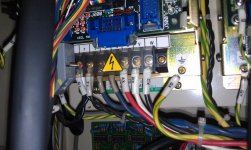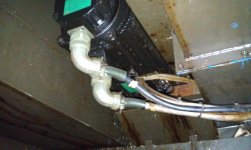Awesome; I'll give this a try. My machine does not have the tool or spindle probe, unfortunately. It does make a cool sound, though.

Tool and spindle probes for this machine are just "dumb" switches and nothing like a high dollar Renishaw.
The tool probe is just a magnetic block mounted on the table and has a spring loaded plunger pad. When the tool contacts the plunger, an electrical circuit is completed between the spindle and the table and the machine records the Z axis position and writes it to the tool file.
The machine as a
REALLY sweet feature where you highlight the tool probe button and then push the cycle start. Machine scans your current CNC part program and grabs the necessary tools called out within the program and brings them to the tool probe location one-by-one. While the machine is in cycle, you manually wheel the Z axis down to touch the probe (tool length is recorded) and then push cycle start again and machine goes home, grabs the next tool in your program and so forth. The only issue is when probing floating reamer holders that do not conduct electricity through the spindle. The workaround is a jumper wire with alligator clips--one end clips on the reamer and the other end clips on a metal object next to the spindle.
The spindle probe is again just a dumb switch with no batteries or anything. The stylus sits on 3 points inside the probe with a spring pulling it down. The stylus will swing freely when it hits an object, but once continuity is made with the table, the position is recorded. You can set Z heights, X plane zero, Y plane zero or set center of a bore by manually probing 3 points. It is so much easier to use than a Renishaw probe running a macro program like I have to use now on a Fanuc machine.
Again, the only issue with this system vs the Renishaw is everything needs to conduct electricity. If you need to probe the surface of a plastic part or anodized fixture, just grab a piece of .001" Starrett shim stock. Place one end on the table under a weight and tape or hold the other end down while you crank the Z axis down to probe the surface. Done.
I miss the Ice Cream Truck. It still lives but it got moved to another building in a different dept. Fun machine.







